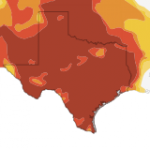While Drought Hurts Farming, It’s Actually Helping the Gulf

Photo by Win McNamee/Getty Images
"Dead zones" in the Gulf of Mexico -- caused by algae blooms linked to fertilizer runoff -- can hurt crabs, shrimp and other animals.
The Midwest is going through one of the worst droughts in decades. The most recent US Drought Monitor map shows about a third of the Midwest experiencing extreme drought levels. More than 80 percent of Arkansas is in extreme drought, with 44 percent at the harshest level, exceptional drought, according to the map.
But while all of this dryness is hurting farming, it’s actually helping the marine life in the Gulf of Mexico.
Less rain in the Midwest means less runoff from fertilizers and other pollutants making its way into the Gulf. That’s good news for aquatic life, because it shrinks what’s known as the “dead zone” there, an area of lower oxygen.
Researchers at the Louisiana Universities Marine Consortium (LUMC) found the area of hypoxia, aka “Dead Zone,” shrank this summer to one of the smallest zones recorded since the researchers began measuring it in 1985. (The size of the zone varies each summer.)
Fertilizers lead to higher nitrate levels in the Mississippi and Atchafalaya rivers, and, ultimately, the Gulf. The nitrates provide nutrients to algae. It then blooms at the sea surface, then dies out, sinks and depletes the oxygen levels near the sea floor. Edward Buskey with The University of Texas Marine Science Institute says this oxygen depletion is toxic to marine life, hence the “dead zone” moniker.
“The mobile animals just tend to avoid the area. They’ll swim away from it as the oxygen gets lower,” he says. “But things that don’t move as fast, like some of the animals that live on the bottom — crabs and clams and shrimp and things like that — if they can’t get out of that area, it will kill them.”
An animation by the LUMC simulates the process and makes it easy to understand.
Last year, with substantial flooding in the Mississippi, the zone was almost two times bigger than this year’s.
Buskey says dead zones occurred all around the world before the use of artificial fertilizers, but have become bigger since.
“It’s something that occurs naturally, but is also something that is made worse by human activities,” he says.
But, with weather being impossible to change, Buskey says there are ways farmers can still fertilize their crops without feeding the dead zone as well.
“By making retention ponds, it attracts wildlife. It’s a good habitat for ducks and fish and things like that,” he says. “And then there are microorganisms in the bottom of the ponds that actually break down the nutrients and then return them to the atmosphere.” By allowing retention ponds to break down the fertilizer, Buskey says, less of it will find its way to the Gulf, and aquatic wildlife will stand a better chance of survival.

